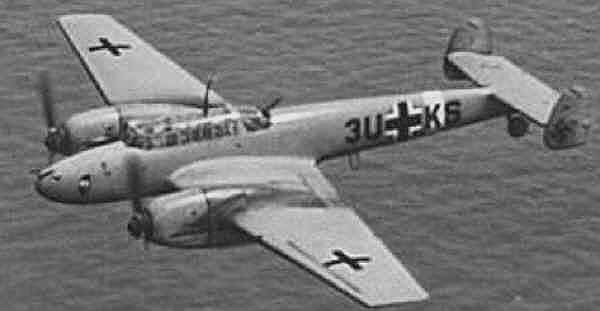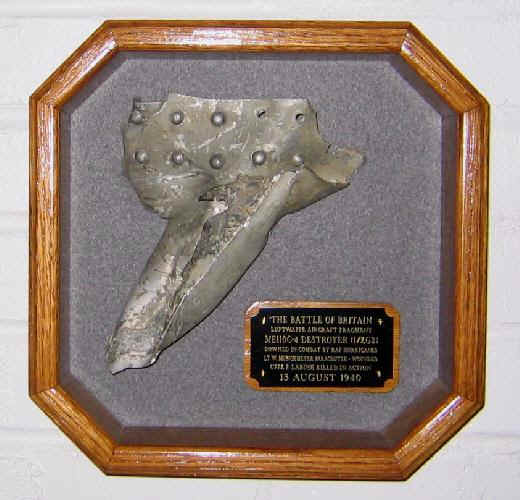
About this Piece of Aluminum -- Aluminum #2 of 2.

ALDERTAG! – (EAGLE DAY)
Göring, the head of the German air force, Luftwaffe, in World War II, had named Aldertag and he put out the orders.
"Adlertag!" -- "Eagle Day" was planned as a day of massive flights of Luftwaffe aircraft. They would arrive over Britain and eliminate the British air force. The Luftwaffe would do to Britain what the Luftwaffe had done other places.
Eagle Day was to be August 13, 1940. The Luftwaffe had already taken control of the English Channel, and the British Channel Islands, Guernsey and Jersey, were occupied by German soldiers.
Now Germany was planning to take possession of English skies. The success of a new Western Front hinged on that Monday – that Eagle Day.
Of the many squadrons that would take part on Eagle Day, one was Flying Commando 3, based in Paris. It had two major flight groups and one had three squadrons of Messerschmitt Bf-110s. The Bf-110s were named "Destroyers." Göring called them his "Ironsides."
The Destroyer was designed to be the destroyer of fighter planes, as well as an effective light bomber. It was faster in level flight than most of Britain’s fighter planes, and it could take much more abuse. It was heavily armed and had powerful twin engines.
It had four machine guns and two cannons with explosive shells in the nose and one machine gun protecting the rear of the plane. It could operate at the service altitude of any other aircraft of the day and it had a range of 876 miles. It was a formidable weapon.
Over 6,000 Bf-110s were built and 350 were available during the Battle of Britain.
These planes had done very well fighting in Poland, Denmark, Norway, and France.
However, leading up to Eagle Day, they were starting to experience some problems over Britain. Put in the simplest terms, the Destroyer, this "Ironsides," could not get out of its own way.
It was a very good aircraft, yes, until the pilot wanted to change direction. His intentions were immediately obvious to the opposing fighters, and with the aircraft's slow turning, any single-seat fighter in Britain could match it. The British fighter was able to turn sharper than the Bf-110 and this permitted the attacking fighter almost unlimited opportunities to fire on the strong German aircraft.
There were a few individual Bf-110 successes and some pilots continued to score with their aircraft, but in general, it was a period of losses. Contributing to this was very poor planning and even worse mission execution on the part of Destroyer air group commanders.
The Destroyer then created what was known as a "defensive circle." Each Bf-110 in the circle would be protecting the tail of the preceding Bf-110 while having his tail protected by the following Bf-110. This was a good defense, but it was no way to pursue an aggressive air war.
The strangest example of this occurred on July 10, 1940, when thirty Bf-110s turned into this "defensive circle" at the approach of only three Hurricanes!
In reality, this circle filled a small part of the sky with a lot of aircraft. These could be seen for miles. This would draw RAF fighters -- and then the very good German fighters, the Me-109s, which were waiting toward the sun, would come down on the overly-anxious RAF pilots.
The presence of the attacking Me-109s contributed to the belief that the circling Destroyers had to have escorts themselves. This was not quite true. They were circling to present an attractive lure to unaware British pilots. Another benefit of attracting the fighters would be to free the German heavy bombers to continue to their targets with less chance of fighter interception.
Also, the circling could "precess," or travel laterally across the ground in any direction. This would offer the maximum protection while disguising their actual ground target. With their near-900-mile range this could be effective.
(Few things are as simple as they first appear.)
Just before Eagle Day, on a July 9 mission, two Bf-110s were shot down. Then the next day, three more were lost. The day after that, another four; one of the pilots was Göring's nephew.
The Bf-110 pilots’ reports of their kills were suspect. In one case, on July 10, they claimed twelve British aircraft were shot down. Research shows that the RAF lost but one Hurricane that day and it had collided with a German light bomber.
The Bf-110 losses continued. On August 10, a flight of 60 lost six and one of these was a squadron commander. The next day, another squadron commander was shot down but was picked up from the sea.
When Eagle Day arrived on the 13th, bad weather caused some flights to be cancelled. Various escort groups were not informed of these cancellations. Even worse, escort flights were recalled without the escorted bomber pilots being notified. In one case, 74 near-defenseless German Dornier light bombers flew alone and unprotected deep into Britain. The RAF was waiting.
A flight of Bf-110s flew on to Portland, England, thinking that German dive bombers had just previously attacked the RAF fighter bases on the Bf-110s’ route. The bases had not been attacked. The RAF was waiting for them, as well.
Thirteen Bf-110s were lost on Eagle Day.
The story of one of them, a Bf-110, Model C-4, is of particular interest.
The Monday afternoon of that August 13, Bf-110 C-4 pilot Lieutenant W. Munchmeyer, while sitting on the ground in Caen, France, went through his preflight checklist and considered his mission requirements. His gunner, Staff Sergeant Friedrich Labusch, was tending to his duties with 750 rounds of ammunition for his rear machine gun.
For Eagle Day, Lt. Munchmeyer was assigned to a flight of 35 Bf-110s.
His overall commander had been in that position for only three days because the previous commander had been killed in his Bf-110.
Lt. Munchmeyer's squadron took off and rendezvoused with some German light bombers. He was to escort them to targets around Southhampton, England, on the central English Channel coast.
Shortly before 4:00 p.m., they were near Winchester, England, just north of Southhampton where British Spitfires were assembled.
Munchmeyer’s flight was attacked by Hurricanes from 601 Squadron. RAF Sgt. L. N. Guy was known to have significant hits on a particular Bf-110C. This aircraft, heavily damaged, dove away from the fighting somewhere in the vicinity of Winchester. On the route from Winchester back to France is the small town of North Badesley.
That day, in a nearby wood, forester Jack Osman was clearing brambles when he heard the whine of aircraft engines and then a loud, nearby thump which shook the ground -- and then silence.
He dropped his billhook and ran to the edge of the wood. He was the first to reach the crash site, but there was little that could be done. As he stood looking at the smoking crater and the remains of a Bf-110, he saw an airman floating down by parachute nearby.
This airman was a badly wounded Lt. Munchmeyer. He was captured as soon as he landed in an adjacent park.
His gunner, Friedrich Labusch, was dead.
Forty-five years later, in 1985, forester Jack Osman returned to the area. He looked at the wood, walked across a small open field and said, "Right here." He stuck his spade in the ground to mark the spot where he remembered the center of the smoking crater to have been.
Members of the Devon Aviation Research and Recovery Team started painstaking aviation archaeological work and removed many artifacts of the Bf-110C-4.

(K. Cashion)
Later, in May 1998, the Wealdon Aviation Archaeological Group performed an additional excavation of the site and one of the pieces removed was a portion of the fuselage rib structure.
I have that piece in an oiled-oak frame hanging on the wall of my English pub.
This represents so much more than mere bent up metal.
Ken Cashion